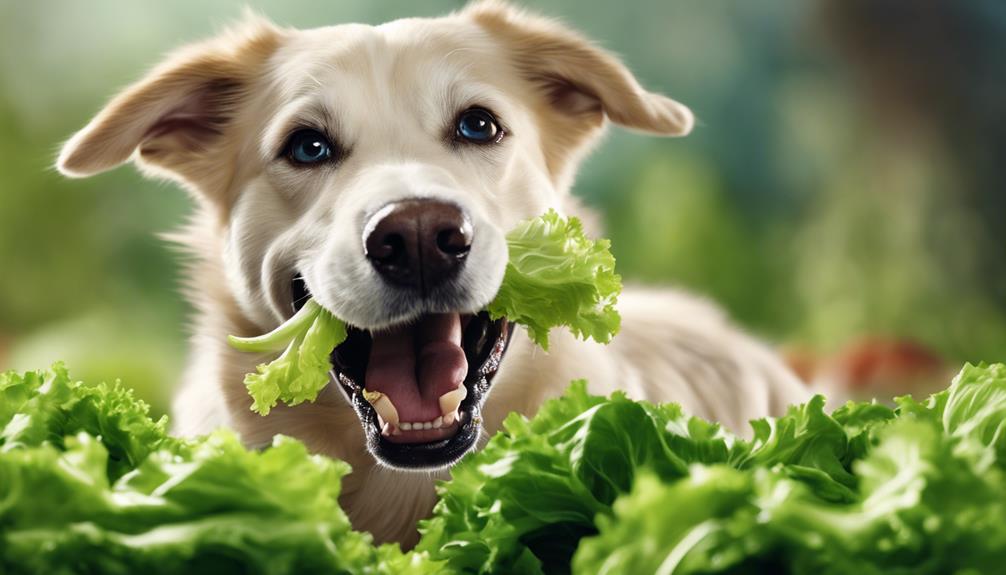Yes, dogs can eat lettuce. It's good for them! Lettuce has beta-carotene and fiber which help keep them healthy. Cutting lettuce into small pieces makes it easier to eat. Remember to avoid the tough middle part. Stick to safe greens like lettuce, not spinach or kale. Feed plain lettuce without any dressings. It's full of vitamins like A, K, and C. Lettuce helps dogs digest food and stay hydrated. It's a great low-calorie snack that can help with weight management. Want to know more about what dogs can eat?
Key Takeaways
- Lettuce provides essential nutrients like beta-carotene and fiber for dogs.
- Safe consumption guidelines include cutting lettuce into digestible pieces and avoiding tough parts.
- Different lettuce types offer vitamins A, K, and C, aiding in digestion and hydration.
- Moderation is crucial to prevent digestive issues from high fiber content.
- Portion sizes vary based on dog size, with lettuce as an occasional treat.
Lettuce Nutrition for Dogs
Lettuce provides dogs with essential nutrients such as beta-carotene and fiber, contributing to their overall health and well-being. This leafy green isn't only low in calories but also high in water content, making it a hydrating snack for our furry friends. Beta-carotene, found in lettuce, is a key factor for vision and bone health in dogs. Additionally, the fiber in lettuce aids in digestion and promotes gut health, keeping our canine companions happy and healthy.
It's important to note that different types of lettuce vary in nutritional content. Romaine and arugula are considered more nutrient-dense options for dogs. While lettuce can be a healthy addition to a dog's diet, it shouldn't be the primary source of nutrients due to its limited nutritional value. So, let's keep in mind to offer lettuce in moderation alongside a balanced diet to guarantee our dogs receive all the necessary nutrients for a vibrant life.
Safe Lettuce Consumption Guidelines
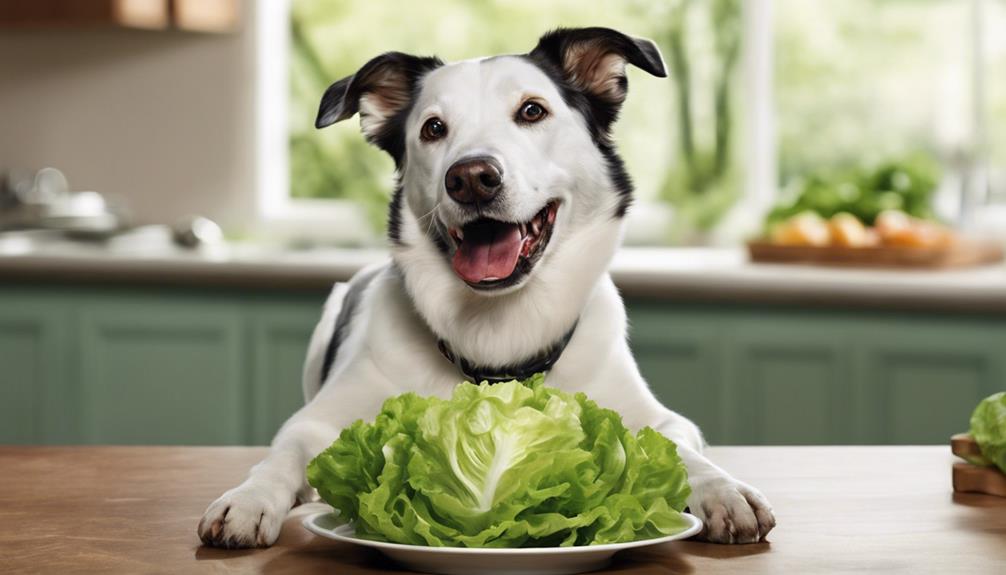
When providing lettuce to dogs, it's important to follow safe consumption guidelines to guarantee against potential digestive issues. Lettuce can be a good source of fiber for your furry friend, but it should be given in moderation.
To guarantee safe consumption, always cut the lettuce into small, easily digestible pieces before feeding your dog. Avoid the crunchy middle section of lettuce, as it can be tough for dogs to break down.
Remember, not all greens are safe for dogs, so stick to lettuce and avoid offering spinach or kale. When feeding your dog lettuce, make sure it's plain and free from any dressings or herbs that could be harmful.
Benefits of Lettuce for Dogs
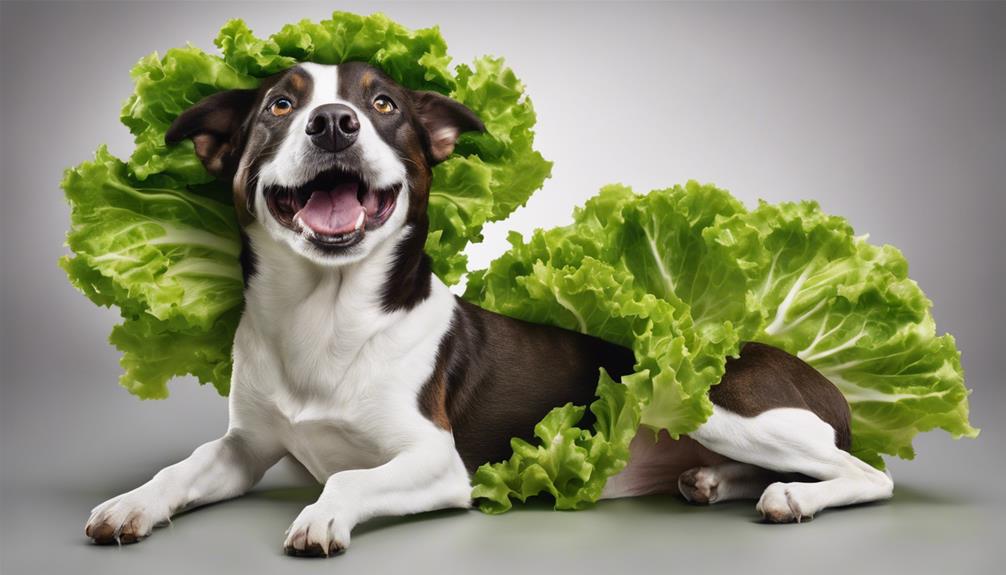
Lettuce offers valuable nutrients for dogs, such as vitamins A, K, and C, essential for their health.
It can aid in digestion and keep dogs hydrated due to its high water content.
Additionally, lettuce serves as a low-calorie snack option, supporting weight management in our furry companions.
Nutritional Value for Dogs
With its low-calorie content and high water levels, incorporating lettuce into a dog's diet can offer numerous health benefits. Lettuce is safe for dogs and serves as a source of vitamins, including beta-carotene, which is important for vision, reproduction, and bone health.
Additionally, being low in calories, lettuce can aid in weight management for our furry friends. Its fiber content makes it good for digestion, promoting healthy bowel movements. Different types of lettuce such as romaine, arugula, and spinach provide various nutrients, making them excellent choices for dogs.
While lettuce shouldn't replace a complete meal, adding it to your dog's diet can supplement their intake with essential vitamins and minerals for overall well-being.
Digestive Health Support
In addition, promoting ideal digestive function, lettuce serves as a valuable addition to a dog's diet due to its high fiber content. The fiber in lettuce aids in maintaining a healthy digestive system for our furry friends.
Additionally, the high water content in lettuce can contribute to keeping dogs hydrated, supporting their overall well-being. Lettuce also offers essential vitamins such as A, K, and C, which are important for various bodily functions in dogs.
Furthermore, incorporating lettuce into a dog's diet can help with weight management, making it a beneficial option for those looking to keep their pup at a healthy weight. By including lettuce in meals, dogs can enjoy a crunchy texture and receive a variety of nutrients that support their digestive health.
Low-Calorie Snack Option
To shift our focus to the benefits of lettuce for dogs as a low-calorie snack option, we find that its high water content and essential nutrients make it a valuable addition to their diet. Lettuce, being 90% water, can aid in keeping our furry friends hydrated, especially during hot days or after physical activities.
Additionally, the presence of beta-carotene in lettuce is essential for supporting various aspects of dog health, such as vision, reproduction, and bone strength. However, it's important to remember that moderation is key when offering lettuce to dogs. Excessive consumption can lead to digestive issues like diarrhea.
While lettuce may not be as nutritionally dense as some other vegetables, when given in appropriate amounts, it can serve as a healthy and invigorating treat for our canine companions.
Risks of Feeding Lettuce to Dogs
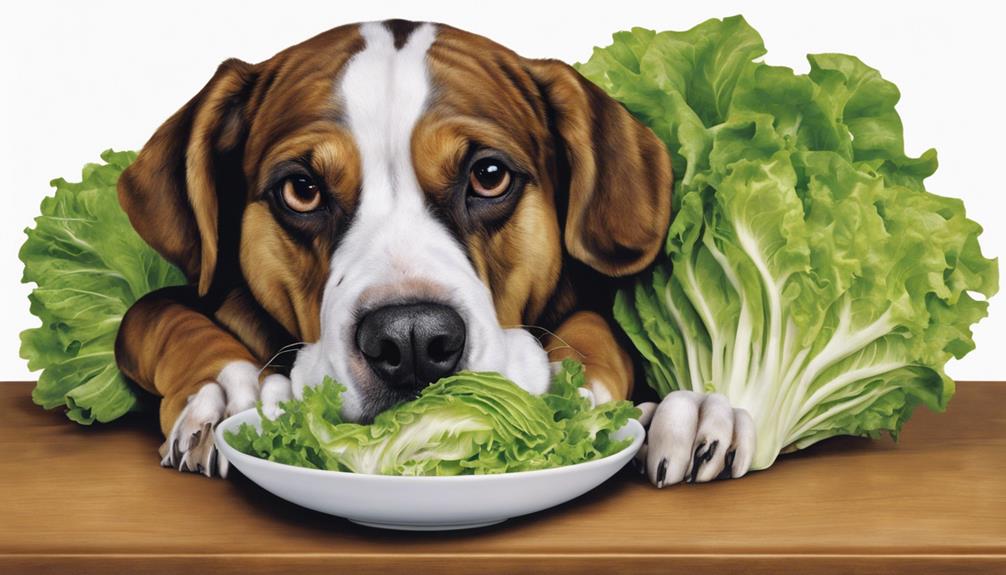
Feeding lettuce to dogs poses potential risks, particularly due to its high fiber content, which can lead to diarrhea when consumed excessively. While lettuce can be a good addition to a dog's diet in moderation, overfeeding can cause digestive issues. The high fiber content in lettuce may be hard to digest for some dogs, especially smaller breeds. This can result in loose stools or diarrhea, affecting the overall well-being of your furry friend. It's important to be mindful of the quantity of lettuce you offer to your dog to prevent such issues.
In addition to digestive concerns, certain types of lettuce like kale contain compounds that could contribute to the formation of kidney and bladder stones in dogs. Ensuring that you wash lettuce thoroughly before feeding it to your pet is vital. Contamination can pose health risks to dogs and may lead to more serious complications. By being aware of these risks and feeding lettuce in moderation, you can incorporate this leafy green into your dog's diet safely.
Lettuce Portions for Canines

After discussing the risks associated with feeding lettuce to dogs, determining appropriate lettuce portions for canines becomes essential for their overall well-being. When deciding how much lettuce to feed your dog, it's crucial to take into account their weight and size. Here are some guidelines to help you make the right choices:
- Guidelines based on weight: Dogs can generally have anywhere from 1/4 cup to 2 1/4 cups of lettuce per day, depending on their weight.
- Adjust portions accordingly: Extra-small dogs should have smaller portions compared to extra-large dogs.
- Introduce lettuce slowly: To avoid digestive issues, start by giving your dog small amounts of lettuce and monitor their response.
How to Serve Lettuce to Dogs
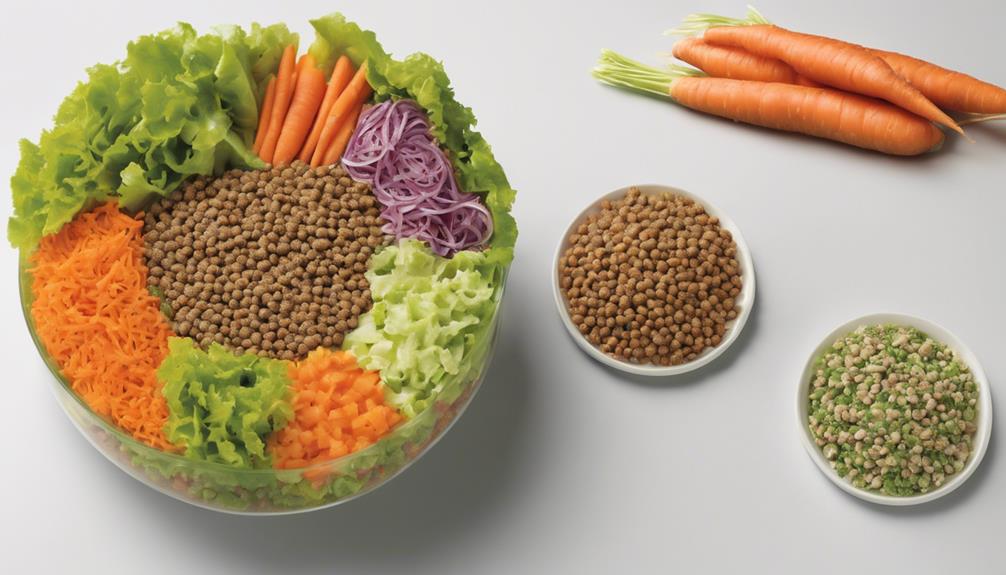
When providing lettuce to dogs, make sure it's washed thoroughly to remove any bacteria and pesticides before giving it as a treat or incorporating it into their usual food. Dogs can eat lettuce, but precautions should be taken to guarantee their safety.
Wash lettuce carefully, then cut it into small pieces to make it easier for your furry friend to chew and digest. Steaming the lettuce can also aid in digestion and make it more appealing to your dog. Remember to serve plain, fresh lettuce without any dressings, herbs, or seasonings, as these can be harmful to your pet.
Offering lettuce as a standalone snack or mixing it with your dog's regular food can encourage consumption. By following these simple steps, you can safely introduce lettuce into your dog's diet and provide them with a healthy treat option.
Raw Vs. Cooked Lettuce for Dogs
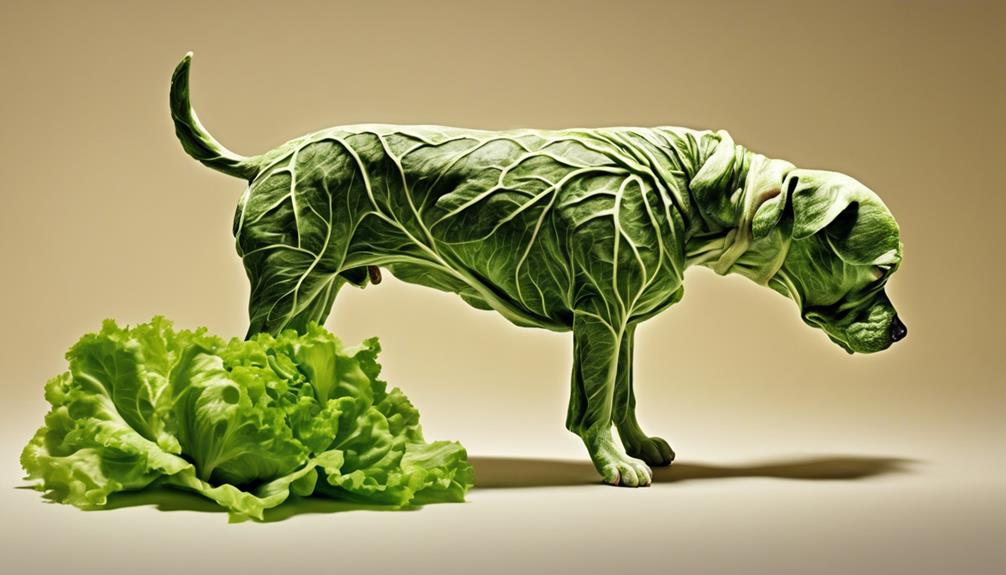
After discussing how to serve lettuce to dogs, it's crucial to comprehend the dissimilarity between raw and cooked lettuce when contemplating it as a component of your pet's diet. Both raw and cooked lettuce are safe for dogs to consume, but there are some factors to ponder when determining which form to provide your furry friend.
- Nutritional Value: Raw lettuce retains more of its nutrients compared to cooked lettuce, making it a preferable choice for dogs looking to munch on something green.
- Digestibility: Cooked lettuce may be simpler for some dogs to digest, especially those with sensitive stomachs or digestive issues.
- Quantity: Dogs can eat lettuce in moderation, but too much lettuce, whether raw or cooked, can lead to digestive upset due to its high fiber content. It's vital to offer lettuce as a treat or supplement rather than a primary food source to avoid overconsumption.
Other Dog-Friendly Greens

Let's explore some other dog-friendly greens that can provide a variety of nutrients and flavors for your furry companion.
Spinach is rich in iron, but it contains oxalic acid, which may hinder calcium absorption in dogs.
Carrots are a crunchy and nutritious alternative to lettuce, offering Vitamin A and fiber.
Green beans are a low-calorie, high-fiber option that aids in digestion and weight management.
Apples are a source of Vitamin C and fiber, promoting good digestion and overall health in dogs. Remember to feed these greens in moderation and monitor your dog's response to make sure they're well-tolerated.
Additionally, cooked sweet potatoes are a tasty and nutritious choice for dogs, packed with antioxidants and fiber.
Incorporating these dog-friendly greens into your furry friend's diet can add variety and essential nutrients to support their overall well-being.
Monitoring Dog Reactions to Lettuce
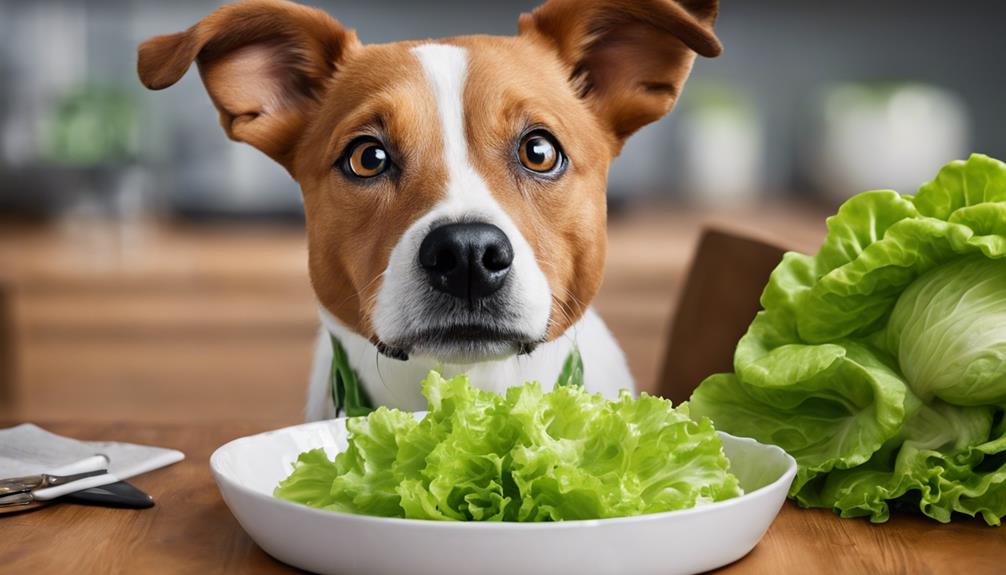
Exploring the effects of introducing lettuce into your dog's diet includes monitoring their reactions for any signs of digestive issues or allergic reactions. When feeding your furry friend lettuce, it's crucial to observe their response to make sure it's safe for them. Here are some key points to take into account:
- Watch for Digestive Issues: Keep an eye out for any changes in your dog's stool consistency or frequency after they start consuming lettuce. Diarrhea can be a common sign of digestive upset.
- Look Out for Allergic Reactions: Be vigilant for any allergic reactions such as itching, swelling, or difficulty breathing when feeding lettuce to your dog. These signs indicate a potential allergy that needs to be addressed.
- Monitor Overall Health: Observe your dog's behavior and energy levels to confirm they're tolerating lettuce well. Any negative changes in health should prompt a visit to the veterinarian for further evaluation.
Lettuce as Occasional Dog Treat
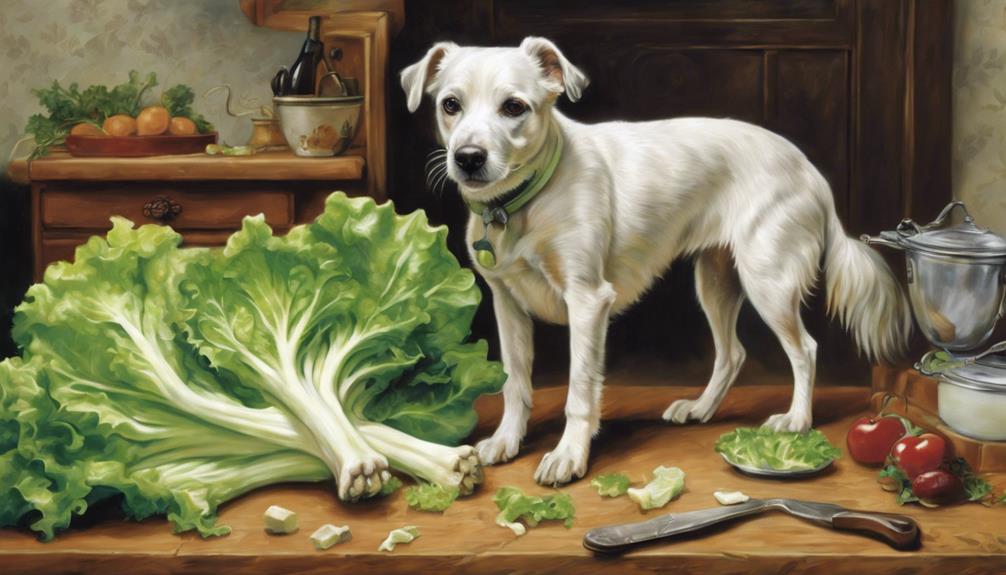
When considering lettuce as an occasional dog treat, it's crucial to provide safe portions to prevent any digestive issues. Lettuce can offer some nutritional benefits like hydration due to its high water content and a source of beta-carotene for vision and bone health.
However, precautions should be taken to guarantee moderation and avoid overfeeding, keeping in mind that while not highly nutritious, lettuce can be a revitalizing snack for your furry friend.
Safe Lettuce Portions
In moderation, we suggest offering dogs lettuce as an occasional treat rather than a primary food source. When it comes to safe lettuce portions for dogs, it's important to take into account the size of your furry friend. Here are some guidelines to help you determine the right amount:
- Dogs on the smaller side may benefit from around 1/4 cup of lettuce per day.
- Medium-sized dogs can enjoy approximately 1/2 to 1 cup of lettuce daily.
- Larger breeds might be able to have up to 2 1/4 cups of lettuce each day.
Nutritional Benefits Overview
Let's explore the nutritional benefits of offering lettuce as an occasional treat for dogs. Even though lettuce is low in calories, it packs a neat punch with essential vitamins A, K, and C. These vitamins contribute to vision, bone health, and overall immunity, making it a good idea to include in your dog's diet. Lettuce is high in water and fiber, aiding in digestion and hydration. To showcase the benefits of lettuce for dogs, here's a table summarizing its nutritional value:
| Nutrient | Function | Benefit |
|---|---|---|
| Vitamin A | Vision health | Supports eye function |
| Vitamin K | Bone health | Helps maintain strong bones |
| Vitamin C | Immunity boost | Supports overall health |
Adding lettuce as a treat can be a healthy choice, providing your dog with a variety of nutrients.
Precautions for Feeding
Feeding lettuce to dogs as an occasional treat demands caution to prevent potential digestive issues. When adding lettuce to your dog's diet, consider the following precautions:
- Lettuce is safe: While lettuce can be a healthy snack, it should be given in moderation to avoid any adverse effects.
- Training treat: Use lettuce as a training treat sparingly to prevent overconsumption and digestive upset.
- Cause diarrhea: Overfeeding lettuce can lead to diarrhea in dogs due to its high fiber content.
Frequently Asked Questions
Is It Safe for Dogs to Eat Lettuce?
Yes, it's safe for dogs to eat lettuce. It can be a healthy snack, but too much may cause tummy troubles like diarrhea.
To help digestion, cut lettuce into small pieces. Avoid greens like spinach and kale, which can be harmful.
Always wash lettuce to remove harmful substances. Serve plain lettuce to avoid toxic ingredients.
Can Dogs Eat Tomatoes and Lettuce?
Yes, dogs can safely eat tomatoes and lettuce as part of a balanced diet. Tomatoes are rich in vitamins A, C, and K, while lettuce is low in calories and high in water content. Both foods help with hydration and provide essential nutrients.
Does Lettuce Settle a Dogs Stomach?
Lettuce can indeed settle a dog's stomach, thanks to its high fiber content that aids in digestion and hydration. Chopped lettuce is easier for dogs to digest, reducing the risk of stomach upset. Offering small amounts can provide a soothing effect.
While beneficial, moderation is key to prevent digestive issues. Remember, a vital diet is important for your furry friend's overall health and well-being.
Can Dogs Eat Lettuce and Spinach?
Yes, dogs can consume lettuce and spinach, but caution is necessary. Spinach contains oxalic acid, harmful for calcium absorption and can cause kidney stones.
Lettuce is a safer option, but moderation is key. Consulting a vet before introducing new greens is wise.
Is It Safe for Dogs to Eat Lettuce if They Can Have Coconut?
Yes, dogs and coconut consumption can be safe. But with lettuce, it depends. While lettuce itself is not toxic to dogs, it can sometimes upset their stomachs. So if your dog can handle coconut, a small amount of lettuce should be alright, but monitor for any adverse reactions.
Conclusion
To sum up, dogs can eat lettuce in moderation as part of a balanced diet. While lettuce can provide some nutritional benefits, it's important to follow safe consumption guidelines and monitor your dog's reactions.
Remember, lettuce should only be given as an occasional treat and not as a primary food source. So go ahead and share a leaf or two with your furry friend, but remember, everything in moderation!
